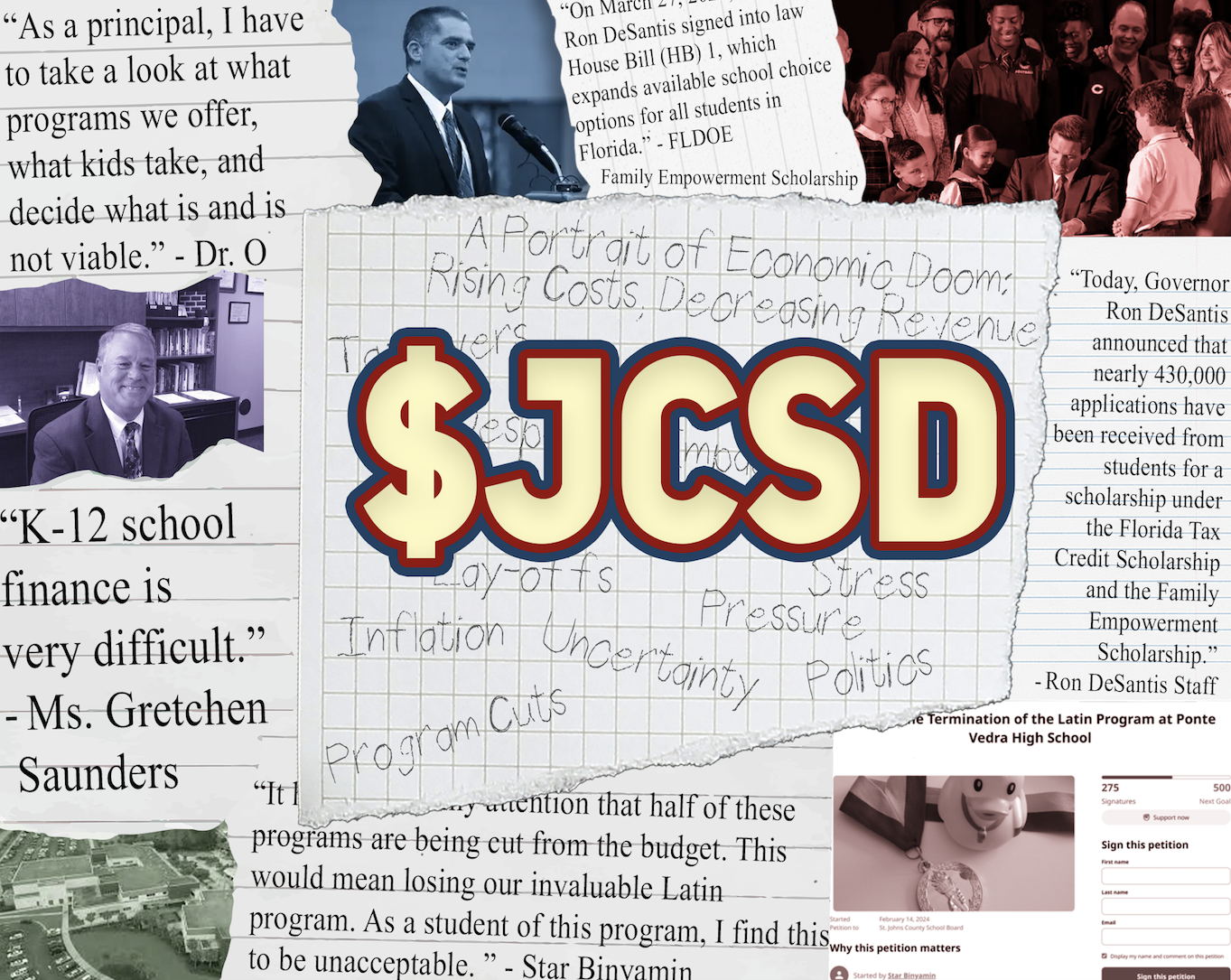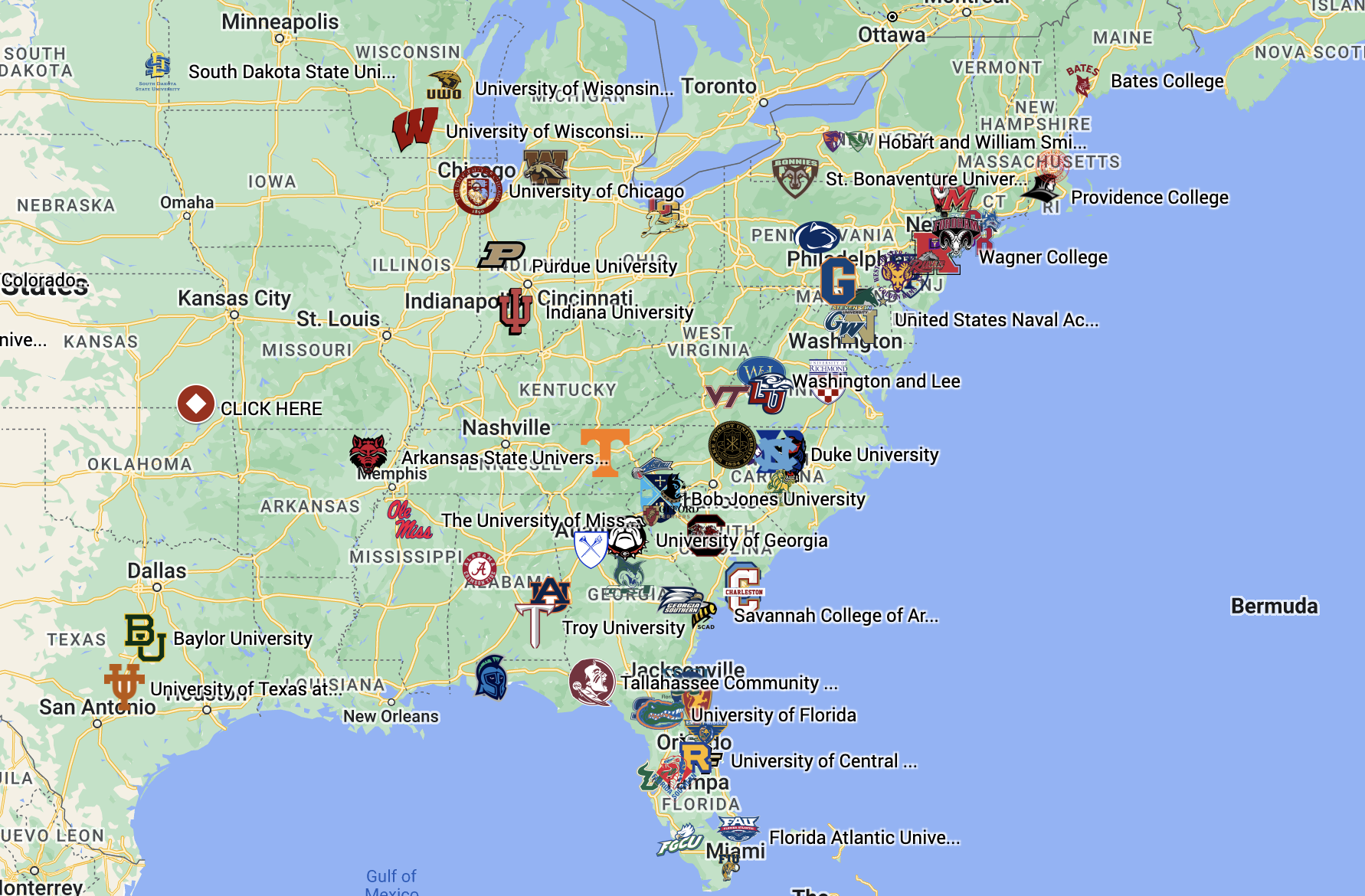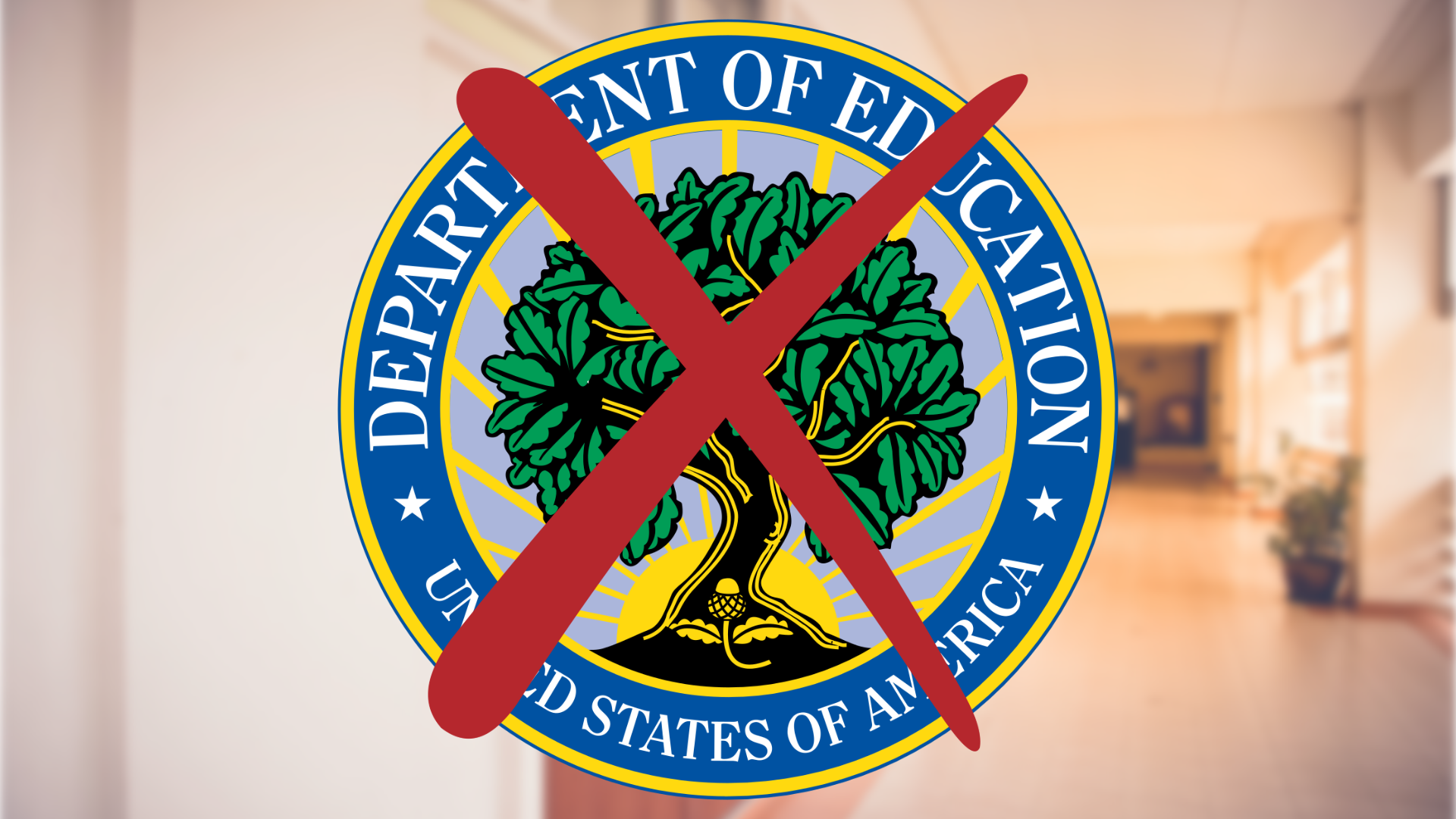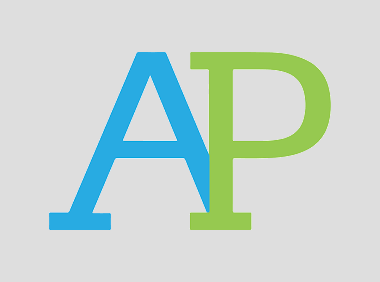By Ben Black
In mid-February of 2024, Ponte Vedra High School (PVHS) students in the midst of class registration for next year were met with unexpected and alarming news: the school’s Latin and Chinese programs, long staples of the PVHS language department, were being cut next year. The loss of these programs, as well as multiple clerical positions, is a result of recent St. Johns County School District (SJCSD) directives to reduce per-school spending for this coming 2024-2025 fiscal year. These budget cuts are primarily caused through a depletion of the SJCSD fund balance, a sort of savings account that helps the school district financially as it battles rising costs, decreasing state funding, and an ever-increasing student population.
I. Into the Depths of Public School Finance
The loss of Latin and Chinese, which caused uproar amongst the PVHS community, must first be viewed through the complicated world of public school funding. “K-12 school finance is very difficult,” stated Gretchen Saunders, SJCSD Chief Financial Officer. In her role as CFO, Ms. Saunders is largely responsible for informing the Superintendent and school board on fiscal matters, as well as managing the district’s one billion dollar annual budget. PVHS Principal Dr. Fredrik Oberkehr concurred, explaining that “we are basically in the job of spending taxpayer money…that makes it difficult.”
When discussing budget cuts and school finance, it is first important to put the size and scope of the school district into perspective. SJCSD is the county’s largest employer, and has a monthly payroll of roughly 36.5 million dollars. Its new schools – which due to unprecedented growth over the past decade, have been under practically nonstop construction – average around 85 million dollars to construct, and around 18 million dollars to staff. The district served 54,145 students at the Florida Education Finance Program’s (FEFP) second calculation, and expects this number to grow by 2,578 before the next school year begins. The FEFP, or as Ms. Saunders referred to it, the “People Magazine of school finance,” listed each student in SJCSD being allocated $8,658.74 in state funding at the 2023-2024 third calculation. For comparative purposes, this number sits above neighboring Clay ($8,552.06) and Duval ($8,493.14), but below the state’s highest, Monroe ($12,534.60), which has a higher property tax millage rate.
“We are basically in the job of spending taxpayer money…that makes it difficult.”
Dr. Oberkehr
Inside the SJCSD budget lie five key spending categories that help with understanding just how complex this organization is, and the financial circumstances the District is currently in. These are the
- Operating Budget, consisting of teacher and support staff salaries, as well as typical operation expenses.
- Capital Outlay, dedicated towards school construction and renovation
- Debt Service, effectively “mortgage payments” for construction. (“Not every school district has $85 million to pay for a new K-8 holding 1,500 students,” stated Ms. Saunders).
- Special Revenue, essentially meant for federal funds and programs such as Title 1.
- Internal Service, comprising of worker’s compensation and health insurance.
Dr. Oberkehr explained that, “there are multiple sources of where funding comes from. There are local sources, state sources, and federal sources.” These all fund the school district, but most major funding issues are decided in Tallahassee, not St. Augustine, making St. Johns schools, like in most of the United States, highly subject to the decision making of state legislatures. An extremely important Florida statute requires all schools to maintain a three percent “fund balance,” which is essentially a portion of the schools budget that operates as a household’s saving account or rainy day fund would. This money can be used like a rainy day fund would, such as if a hurricane hit St. Johns County and schools require major repairs. However, this money is often used to cover holes in other portions of the budget, in areas as diverse as school security, textbooks, and transportation.
As previously stated, the state of Florida requires a three percent fund balance. If a district gets below this number, the state Department of Education takes over district finances. As of June 30th, 2023, SJCSD maintained 43.8 million dollars in fund balance, a 5.4 percent fund balance and a percentage that seems well above the state requirement. However, this fund balance has been built up over many years, and has typically been from 15 percent-17 percent. At these levels, the district is able to obtain a better rating from credit agencies like Standard and Poor or Moodys, decreasing long term costs of new school construction. The district also prefers to not be in a precarious financial position should an emergency take place, and aims to maintain coverage of somewhere between 60 to 90 days of expense coverage, according to Ms. Saunders. 30 days of expenses would be about 56 million dollars, while 60 days would run about 112 million dollars.
When taking all of these factors into consideration, it is easy to follow the district’s reasoning behind why fund balance must increase. At this point in time, the easiest way to return to financial security is to cut expenses. But this all begs the question: why did fund balance get so low in the first place?
II. A Portrait of Economic Doom: Rising Costs, Decreasing Revenue
The most simple explanation for a decrease in the fund balance is the same that ordinary St. Johns County residents have been feeling over the past few years: rising costs. Inflation has made the cost of running a school district far more expensive than before, explained Ms. Saunders, in everything from the cost of printer paper to the electricity bills. Additionally, in order to comply with higher minimum starting teacher salaries set by the state legislature last year, teacher salaries have increased at great cost to the district. After these increases, starting teacher pay is almost identical to neighboring Clay and Duval counties, but teacher top-out pay remains slightly lower as teachers work for more years. Per-student funding has not kept up with all of these increasing costs, and thus the district tapped into the fund balance to remain operable.
While rising costs offer an easy explanation to the District’s financial troubles, it is difficult to call it the primary factor. A series of decisions by the state legislature over the past two decades have heavily contributed to a decrease in the district’s income.
In late March 2023, Governor DeSantis signed House Bill 1, significantly increasing the state’s private and home school voucher system, now called the Family Empowerment Scholarship. Proponents of this bill largely believe in school choice and the use of public school money to subsidize private education. As Ms. Saunders noted, St. Johns County Schools is not “for or against these scholarships. But we are certainly affected by it.” With 4,115 students in the county receiving a roughly $8,000 dollar scholarship from the state, SJCSD has seen a loss of 32.1 million dollars in state funding that is instead directed to scholarships since the signing of the bill. This is not money that is expected to come back, and directly impacts the services that are able to be offered to current public school students.
“Families are able to apply for an approzimately $8,000 scholarship for either private or homeschooling familiers regardless of whether of not their student was previously enrolled in a public school”
Under the Family Empowerment Scholarship, families are able to apply for an approximately $8,000 scholarship for either private or homeschooling regardless of whether or not their student was previously enrolled in a public school. “Families now get $8,000, but the district never got credit for the student [prior to them applying for the scholarship],” stated Dr. Oberkehr. “The school district never got credit for that kid, but now we have to come up with over $8,000 to send them to private school.” This applies for homeschool students as well. This increases the financial toll on the district as they never received money in the past for students who are now receiving the scholarship. It is just money taken out of their state funding.
The legislature is also in control of much of school district property tax revenue. From 2007-2011, property tax millage rates earmarked for schools were decreased from 2.0 mills to 1.5 mills, and despite the economic growth since this era, the Florida State Legislature has not allowed counties to rise rates since. The SJCSD website elaborates on the issue, stating “As an example, despite an increase of 18.85 percent in property values this year [2023], the capital outlay millage remains at 1.5 mills rather than the previous levy allowed by law of 2.0 mills. Thus, the ability to raise revenue commensurate with the District’s capital needs is severely restricted.” Ms. Saunders explained that even as home values recovered after the Great Recession, school districts were topped out in the money they could receive. This policy, she says, “gives taxpayers a break on property taxes, but really hurts the schools.” The decrease in per-student revenue from the state, which has still not been brought back to 2007 levels, is yet another issue that compounds into a decrease in the fund balance.
Per-student funding from the state is categorical, meaning the vast majority of dollars are allocated to specific sectors like transportation, school safety, special education programs, etc, and these dollars cannot be transferred to use in other sectors. Few dollars are given to the district for operations. A simple example from The Florida Education Finance Program shows that the district receives $15.5 million this year to fund school transportation. This past year, the district spent $23 million. That gap is closed by the fund balance, and makes it evident why cuts to transportation, such as field trips and sporting events, have been put in place in recent years.
Another source of state funding to SJCSD, lottery money profits from the Florida Lottery, have also been steadily decreasing since 2015. “When you see the Florida Lottery billboards on the highway advertising the amount of dollars given back to Public Education, you assume the lottery money is going to local K-12 schools. But that just isn’t the case,” detailed Ms. Saunders. This money is split amongst colleges and universities, programs such as the Bright Futures Scholarships, and the Florida School Recognition Program Award funding. The distribution of lottery funds to public schools comes from this recognition program, and funds appropriated for this program are based on the school grades earned in the previous school year and the number of students counted in the FEFP fourth calculation. Each school awarded these dollars must vote how the dollars will be spent. If a decision is not reached by February 1, the award must be equally distributed as a bonus among all classroom teachers currently teaching in the school. The school staff and school advisory council must vote on how the funds will be distributed and how much each person will receive. In previous years these dollars were allocated based on the number of students enrolled at the school and not based on the individual schools’ annual academic grade. (PVHS staff vote to give ten percent of this award to the school’s general fund, but other schools may differ in how they allocate their funding).
Additionally, many PVHS students and teachers wrongly assume that the current budget cuts have to do with an expiration in federal COVID-19 grant money. Ms. Saunders explained these grants and their impact on SJCSD school finances at length, saying that “pandemic money was given based on the number of Title 1 schools in a district.” Title 1, according to the U.S Department of Education, gives federal money to lower income students; a Title 1 school has a high proportion of low income students who receive this aid. Due to SJCSD being a high socioeconomic area, the county received $45 million dollars in funding; this is compared to other districts in the state, many of which received upwards of $500 million dollars.
SJCSD used this money to fund efforts to improve pandemic learning – WiFi hotspots, desk shields, and water filtration systems were all purchased using this money. “These efforts supported the whole district, and added nothing to fund balance,” stated Ms. Saunders. Due to the disparity in federal money grants to different counties in the state, some counties are still able to rely on these funds even though the legislature has not raised per-student funding. In this way, St. Johns County may be one of the first districts experiencing what will soon be a statewide financial crisis in public education.
III. Nonstop Growth, Nonstop Construction
Despite the rising operating costs and decreasing state funding, a key element of the district’s financial woes lay in the costs associated with a rapidly growing student population. “The only other county experiencing this type of growth is Polk [county, south of Orlando],” stated Ms. Saunders, helping to frame the unique circumstances of St. Johns County even in the fast growing state of Florida. According to a presentation made to the St. Johns County Board of County Commissioners last fall, over the past ten years, there has been a growth of 13,467 students in the county. Nine new schools have been built, with three major school expansions over that time. In 2024, two new K-8 schools will open. One more will be opened in 2025, and two more in 2026.
Funding from the state for new schools comes in what is called the Local Capital Improvement Fund. The District website lays out current circumstances in simple terms. “Revenues for the Local Capital Improvement Fund are projected to be $78.1 million, or approximately $9.4 million more than the prior year; yet in 2007-08 the Local Capital Improvement Funds generated approximately $46.8 million. This equates to an approximate 19 percent increase in revenue for capital projects, while at the same time the number of students being served increased by 95 percent from 27,737 students in 2007-08 to 54,145 students in 2023-24. Since 2007-08, the capital outlay budget has lost access to more than $312 million.”
While these sources are in dire conditions, other funding sources theoretically should also help with new school construction. One of these is the impact fee, a tax developers pay when new homes are built that goes to fund local infrastructure, including schools. St. Johns County typically keeps these rates extraordinarily low, and last fiscal year, the school district received $12 million in impact fees. Again, K-8 schools often cost upwards of $85 million to construct. This gap is covered through bond sales and loans, as well as the half cent sales tax that will be on the ballot this fall for renewal, as well as through the fund balance.
Even as the district faces a rapidly growing student population, it still must keep class sizes at their state mandated levels (18 students/class K-3, 22 students/class 4-8, 25 students/core class 9-12). But this mandate is hard to maintain with the lag in funds caused by such rapid population growth. Each fall and spring, students are counted and funded by the state using the “cheeks in seats” method, as Ms. Saunders dubbed it. New students that are counted are then given per-student funding by the state in the next semester of schooling. In an area with minimal population changes, this system works perfectly fine. But in SJCSD, for example, the student count last spring took place on Feb. 15, and over 500 students enrolled in SJCSD before the next count during summer. These students will not receive any funding until June 30, leaving almost five months where the district must cover the cost of educating these students, largely relying on fund balance.
IV. Changing Finances, Changing Education
“St. Johns County has enjoyed over the past several years being able to support kids above and beyond,” Dr. Oberkehr stated. After meeting state graduation requirements, districts are able to allocate funds where they see the best fit for their community. Services that many families take for granted, including media specialists and school nurses, are not actually required or funded by the state. The SJCSD Fund balance has been funding many of these excess programs, but “if you continue to rely on fund balance year after year after year, it just is not going to work,” explained Dr. Oberkehr.
“As a principal, I have to take a look at what programs we offer, what [classes] kids take, and decide what is and is not viable.”
Dr. Oberkehr
Under the current circumstances previously described, SJCSD instructed school principals to look at their budgets for next year and make specific reductions. “[Reductions] were significant, in the hundreds of thousands of dollars,” stated Dr. Oberkehr, including personnel and other cuts. “As a principal, I have to take a look at what programs we offer, what [classes] kids take, and decide what is and is not viable.”
PVHS is in a unique position due to 104 funding, effectively dollars from the College Board given to the school after students pass AP Exams (read earlier reporting on PVHS AP funding) that the school adds to its budget. Programs like Latin and Chinese have long been funded by this excess money, but “this is the first year that we have exhausted that funding,” said Dr. Oberkehr. A variety of factors have caused this depletion, from rising AP Exam costs (which receive funds to pay for student exams), higher teacher salaries, and the extremely volatile increases in health insurance (sometimes upwards of 18 percent year over year) costs that must be covered by the school. “The fact that we have exhausted approximately 1.6 million dollars in 104 funding…” stated Dr. Oberkehr, is another indicator of struggling finances.
Under all of these circumstances, cuts were needed. “Whenever administration looks at cutting spending, the first place they are going is administration… we are losing two clerks. But that just wasn’t enough,” Dr. Oberkehr explained.
“To be honest, I feel like we held onto Chinese and Latin longer than we should have, but I was able to do that,” Dr. Oberkehr continued. The reasoning behind cutting these programs derives from their low enrollment: both languages have roughly 45-50 students enrolled in all levels of program, all the way from Chinese or Latin 1 to the Advanced Placement level. This stands in stark contrast to a class like AP Psychology, where even after last August’s brief statewide ban, still has 160 students registered to take it next year. And that is just one course. “We have more kids enrolled in a single class than we do entire programs,” explained Dr. Oberkehr.
Additionally, the district is moving from a 5:2 course funding split, where five classes are funded at 25 students per class and two classes are funded at 40 students per class, to a lower allocation. “Now, they will be going to a 4:3 [course funding split],” stated Dr. Oberkehr, meaning four classes are funded at 25 students per class and three classes are funded at 40 students per class, leading to class size increases. “Our teacher allocation is going to go down. And that is the reason that the positions being lost are being lost.”
V. Real Impacts on Real Lives
The backlash to the cutting of these language programs at PVHS was strong and swift. Along with parent backlash, “Save PV Latin” posters were quickly spotted on bulletin boards across the school. The group, organized by current Latin students and not endorsed by any school personnel, has a Change.org petition (link here) with 275 signatures at the time of writing. Their petition explained many of the reasons why they believe the program is valuable, from better English skills to improved college applications.
Star Binyamin, a PVHS sophomore and lead organizer of the group, stated that “Latin has been incredibly useful to me in understanding English vocabulary and scientific terms. I place a similar value in the community surrounding our schools Latin program… Both of these languages look impressive to colleges and teach students how to think methodically.” Matthew Pak, a PVHS sophomore and current Chinese student, places similar value in the language he has spent years learning. “I value Chinese as a language because it helps me connect to a whole other population and culture… I also won’t be able to get the recommended four consecutive years of a language as suggested by schools such as the Ivy Leagues.” Dr. Oberkehr explained how he understood these students’ love of their language and importance to their futures, but it ultimately was a numbers game. “Those 45 kids in each of those programs are important. Of course they are important. I would love to offer it. But we have supported those programs long after their existence could be [fiscally] justified.”
A major issue cited by students and parents has been the timing of the announcement that the programs were being cut. “Since the school didn’t handle informing us well, I did not know the course had been cut until I was handing in my requests for next year,” explained Star. This meant students had to scramble to fill their schedule without knowing what other options they may have. Dr. Oberkehr responded to these concerns by detailing that “When the registration process started, Chinese and Latin were still on the books. We were still working on the budget, and I did everything I could.” Sadly, the human costs of these cuts have resulted in two language teachers losing their jobs.
“While I do understand these programs were cut due to low enrollment in a time of budget cuts, I do not feel it is justified.
Star Binyamin
Now, the only languages offered at PVHS are Spanish and American Sign Language, and students like Star felt it was too late to start a whole new language study. In order to continue his language studies in Chinese, Matthew will be taking a “zero hour dual enrollment class to continue to pursue Chinese” next year, an opportunity which will allow him to continue his studies but not have the detailed course progression that was previously offered. No such imperfect solution exists for Latin, with Star stating that “A few other students and I plan to take Latin 3 online next year.. Online classes often struggle to provide the same level in quality of instruction.. And FLVS [Florida Virtual School] only provides up to Latin 3.”
Star described how “While I do understand these programs were cut due to low enrollment in a time of budget cuts, I do not feel it is justified. It seems absurd to cut integral language programs when so many other programs show no signs of budget cuts.” She, like many other students, were also upset with the cuts as they see improvements in other areas of the school. “My art class has been promised new tablets next year and my academy class has all new furniture- including multiple TVs nobody uses,” Star continued. “I know funding is rarely simple and different amounts can be used for different things, [but] I think we should place more emphasis on academic electives.” Dr. Oberkehr responded to these criticisms directly, stating that “The academy programs take certification exams, and we receive funding when kids pass those certification exams, to the tune of maybe $100,000 a year. That money helps fund those academy programs.” In other words, funding for specific programs cannot just be shifted around entirely based on administrator discretion, again showing the complexity of the school budget.
PVHS’ lunch tutoring program was cut for the remainder of the 2023-2024 school year, but will be funded for the next year. This program offers stipends for teachers who teach high-enrollment classes, mainly graduation requirement courses like Biology and Algebra, to tutor during lunch three times per week. Since the time of original Tiburon reporting, the program was cut entirely and then brought back for next school year. “Lunch tutoring was approved through the contract negotiations with the teachers’ union,” explained Dr. Oberkehr, but it was never part of teachers’ contracts. However, as Biology and AP Environmental Science teacher Ms. Megan Goyette explained, teachers “relied on that money, and cutting it certainly stirred emotions with teachers.”
The cuts “hurt a lot of us, both students and teachers” said Ms. Goyette, as having this extra time helps fit in required remediation and extra instruction (read earlier Tiburon reporting on grading policies). Dr. Oberkehr explained the reasoning behind the potential loss of the program, saying that “[lunch tutoring] was about 40-45 thousand dollars… which is pretty darn close to a teacher’s salary… do you want to lose another teacher, or do you want to lose lunch tutoring?” Many principals have to take similar positions when confronted with budget cuts.
VI. An End to the Madness
Despite the bleak outlook for school finances, Ms. Saunders feels that this should be the worst of the cuts that are seen for some time. “We aim to keep building a sustainable fund balance,” she explained, and says future cuts will be looked for in other areas that do not directly affect instruction. This includes changes in areas such as the purchasing of cleaning supplies and the usage of copy machines. Dr. Oberkehr concurs, stating, “I am confident that the things the district has put in place – the things that they have asked of the building principals – is enough to put us in a good place so we are not going back to this next year or the year after.” However, he offhandedly expressed some concern with the current political environment, stating “But if the legislature says we are going to take 30, 40 million dollars away from you…”
On a more philosophical level, many stakeholders have concerns about where the current cuts will take SJCSD in the future.“When Mr. Speziale was principal here, he wanted Ponte Vedra High School to be that high school that maybe offered those things that only private schools offered,” said Dr. Oberkehr, illustrating that these cuts have a direct impact on school choice and quality of instruction. With the rise in vouchers and a state legislature reluctant to raise funding, these cuts could start a downward spiral in the quality of education in both SJCSD and the state.
SJCSD is typically ranked at the top of public schools in the state, rising to the top in areas from test scores to student graduation rates and AP exams taken. But Star Binyamin expressed worries about if this will be kept up as the county grows and the budgets decrease. “St. Johns must be incredibly careful about how they handle this population growth if people are primarily moving to gain access to such great schools. Despite the rate at which schools are being established, none seem to be any less full – yet we run the risk of losing the quality programs that set us apart.”





